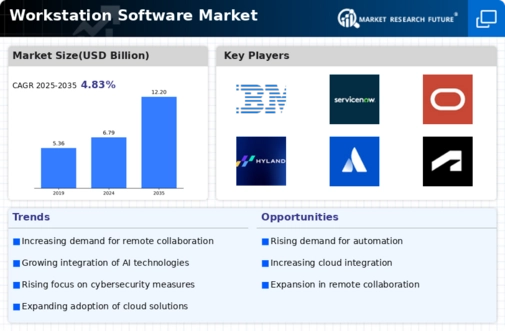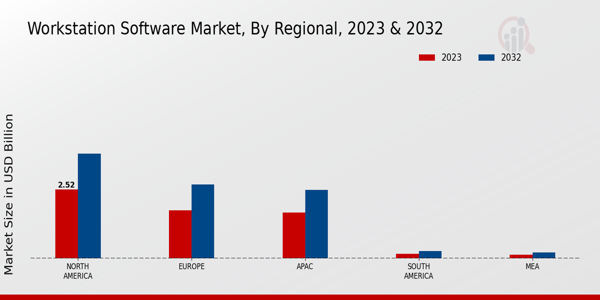Market Growth Projections
The Global Workstation Software Market Industry is poised for substantial growth, with projections indicating a market value of 6.79 USD Billion in 2024 and an anticipated increase to 12.2 USD Billion by 2035. This growth trajectory suggests a compound annual growth rate (CAGR) of 5.46% from 2025 to 2035. Such figures reflect the increasing reliance on workstation software across various sectors, driven by technological advancements and evolving workplace dynamics. The market's expansion is likely to be influenced by factors such as remote work trends, cloud adoption, and the need for enhanced cybersecurity measures.
Increased Focus on Cybersecurity
The Global Workstation Software Market Industry is witnessing an increased focus on cybersecurity as organizations prioritize data protection. With the rise of cyber threats, businesses are investing in workstation software that incorporates advanced security features. This trend is driven by regulatory requirements and the need to safeguard sensitive information. As a result, software solutions that offer encryption, secure access, and threat detection are gaining traction. The emphasis on cybersecurity not only enhances user trust but also contributes to the overall growth of the market, as organizations seek to mitigate risks associated with data breaches.
Emerging Markets and Global Expansion
Emerging markets are becoming increasingly relevant in the Global Workstation Software Market Industry. As economies develop, there is a growing demand for advanced software solutions that cater to diverse business needs. Companies are expanding their operations globally, seeking workstation software that can support various languages and regulatory requirements. This trend is indicative of a broader shift towards globalization, where businesses aim to enhance their competitive edge. The expansion into emerging markets presents significant opportunities for growth, as these regions are expected to contribute substantially to the overall market dynamics.
Rising Demand for Remote Work Solutions
The Global Workstation Software Market Industry experiences a notable increase in demand for remote work solutions. As organizations adapt to flexible work environments, software that facilitates collaboration and productivity becomes essential. This trend is underscored by the projected market value of 6.79 USD Billion in 2024, reflecting a shift in operational paradigms. Companies are increasingly investing in workstation software that supports remote access, virtual collaboration, and project management. This demand is likely to drive innovation and enhance user experience, ultimately contributing to the market's growth trajectory.
Growing Adoption of Cloud-Based Solutions
The shift towards cloud-based solutions is a significant driver in the Global Workstation Software Market Industry. Organizations are increasingly adopting cloud technologies to enhance scalability, flexibility, and cost-effectiveness. Cloud-based workstation software allows users to access applications and data from anywhere, facilitating remote work and collaboration. This trend is expected to contribute to the market's growth, with a projected value of 12.2 USD Billion by 2035. The ability to integrate cloud capabilities into workstation software is likely to attract more businesses, further propelling the industry's expansion.
Technological Advancements in Software Development
Technological advancements play a pivotal role in shaping the Global Workstation Software Market Industry. Innovations in artificial intelligence, machine learning, and cloud computing are transforming how workstation software is developed and utilized. These technologies enable enhanced functionalities, such as predictive analytics and real-time collaboration features. As organizations seek to leverage these advancements, the market is expected to grow significantly, with a projected CAGR of 5.46% from 2025 to 2035. This growth indicates a robust interest in integrating cutting-edge technologies into workstation software, thereby improving efficiency and user satisfaction.
























